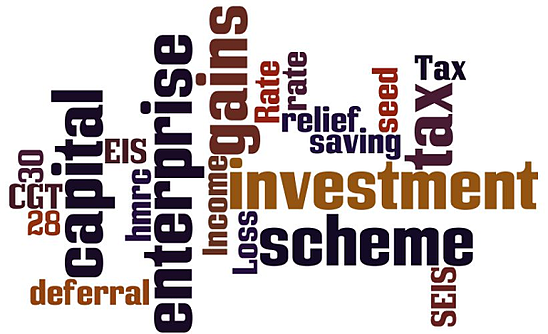
This is the second part in a series of blog articles about EIS tax reliefs. In the first article I covered tax reliefs that are available for income tax. In this article I shall cover the capital gains tax reliefs. Just to remind you there are six important EIS tax reliefs, all of which I will cover in a series of blog articles as follows:
-
Income Tax Relief (see "Part One - Income Tax Relief").
-
Capital Gains Tax Re-investment Relief (this article).
-
Capital Gains Tax Exemption (this article).
-
Loss Relief against Income or Capital Gains (this article).
-
IHT Relief and Business Property Relief (future article).
-
Business Investment Relief (future article).
In this second article, I will cover the Capital Gains Tax reliefs.
1. Capital Gains Tax Re-Investment Relief
For qualifying UK investors who have realised gains within the last 36 months, or expect to realise gains in the twelve months following investment, Capital Gains Tax Re-Investment Relief will be available. In order to qualify for this relief, the investor must be a UK Resident. Capital Gains Tax Re-Investment Relief is also available in some instances to Trustees who are UK Resident.
Whilst there is an annual investment limit of £1,000,000 for Income Tax Relief under the scheme, there is no upper limit for Capital Gains Tax Re-Investment Relief (subject to the company raising no more than £5m in a 12 month period from a combination of Enterprise Investment Scheme investors, Venture Capital Trusts and other forms of State Aid).
The Capital Gains Tax Re-Investment Relief continues for as long as the Investor holds the qualifying Ordinary Shares. This is the case even if after three years of (qualifying) trade, the Company changes the nature of its trade to a non-qualifying activity. When the Investor sells or gifts his shares, the deferred gain will come back in to charge at the rate of Capital Gains Tax applicable in the year of disposal. Spouse transfers are not ordinarily an occasion of charge.
For example, a subscription for qualifying Ordinary Shares made on 31 October 2013 can be used to defer gains generated from 1 November 2010 to 31 October 2014. Gains between 6 April 2008 and 22 June 2010 are subject to a maximum rate of 18%. Gains made from 23 June 2010 will attract a capital gains tax rate of either 18% or 28%. If the disposal qualifies in full for Entrepreneurs Relief (post 5 April 2008), the effective rate of tax will be 10%.
In summary:
Assuming a subscription for ordinary shares is made on 31 May 2013, capital gains made in the following periods can be considered for Capital Gains Tax Re-Investment Relief:
|
Period |
Tax Year |
Rate of Capital Gains Tax Payable |
|
1 November 2010 to 5 April 2011 |
2010/2011 |
28% |
|
6 April 2011 to 5 April 2012 |
2011/2012 |
28% |
|
6 April 2012 to 5 April 2013 |
2012/2013 |
28% |
|
6 April 2013 to 5 April 2014 |
2013/2014 |
28% |
|
6 April 2014 to 31 October 2014 |
2014/2015 |
28% |
A claim for Capital Gains Tax Re-Investment Relief must be made within 5 years and 10 months of the end of the tax year in which the original disposal was made.
Example calculation of Capital Gains Tax Re-Investment Relief:
|
CGT @28% |
||
|
Capital Gain |
|
£100,000 |
|
Capital Gains Tax Re-Investment Relief |
£(28,000) |
In the above example the investor makes a disposal which results in a Capital Gain (ignoring available Capital Gains Tax exemptions) of £100,000. By subscribing for £100,000 of ordinary shares in an EIS and claiming Capital Gains Tax Deferral Relief, the Investor will defer between £28,000 of capital gains tax.
Effect on Cost of Investment in an EIS Company:
|
CGT @28% |
||
|
Investment into the EIS company |
|
£100,000 |
|
Less: CGT Re-Investment Relief |
|
£(28,000) |
|
Net immediate cost of Investment |
£72,000 |
On disposal of his ordinary shares, the original Capital Gain of £100,000 will come back into charge and be taxable at the capital gains tax rate applicable at that time. The individual can then consider whether to reinvest in a further Enterprise Investment Scheme opportunity to attract a further deferral period and claim further income tax relief on investment.
The sale or non-spouse gift of the ordinary shares is an occasion of charge. Inter-spouse disposals of the ordinary shares do not bring the original gain back into charge until the donee spouse subsequently gifts or disposes of their shares.
Income Tax Relief and Capital Gains Tax Deferral Relief combined:
|
CGT @28% |
||
|
Investment in the Company |
|
£100,000 |
|
Income Tax Relief at 30% |
£(30,000) |
|
|
Capital Gains Tax Re-Investment Relief |
|
£(28,000) |
|
Net immediate cost of investment |
£42,000 |
In this example the Investor makes a disposal which results in a Capital Gain (ignoring available capital gains tax exemptions and reliefs) of £100,000 and also claims the available Income Tax Relief. By subscribing for £100,000 of ordinary shares and claiming Capital Gains Tax Re-Investment Relief, the Investor will defer £28,000 of capital gains tax, depending on the rate applicable at the time of that disposal.
Additionally, an income tax credit of £30,000 (subject to having income sufficient to utilise the relief in full) would be available in the tax year that subscription was made.
The net immediate cost of the investment has therefore been reduced from £100,000 to £42,000.
2. Capital Gains Tax Exemption
Provided the ordinary shares are held for the minimum qualifying period of three years from the date of issue, or the date the trade commenced if later, any subsequent gain made on the disposal of the ordinary shares will be exempt from Capital Gains Tax.
|
£ |
|
|
Realised value of shares after 3 years |
150,000 |
|
Less: original cost of investment in the Company |
(100,000) |
|
Tax free gain |
50,000 |
|
Tax saved, compared to a non EIS share disposal |
£14,000 |
3. Loss Relief against Income or Capital Gains
Share values can also decrease. In the event that the ordinary shares are held for the minimum qualifying period of three years from the date of issue (or commencement of trade if later), are disposed of for a market value consideration less than the original investment, an allowable loss will arise.
The amount of the loss is calculated after taking into account the Income Tax Relief that remains allowable. The resultant loss can be set against:
-
capital gains generated in the tax year of the disposal or thereafter, or
-
taxable income of the current or preceding tax year.
Any excess loss would subsequently be carried forward and set against future capital gains.
For example, in the event that a £100,000 investment (net of Initial Charge) is made by a 45% tax payer and the whole investment is lost, after taking account of the Income Tax Relief of 30% claimed on investment, and the subsequent offset of the loss of £70,000 (i.e. £100,000 investment less Income Tax Relief claimed) against income, the Investor has only lost 38.5% of the original investment made, assuming all available reliefs can be utilised in full.
|
Loss Relief Example: |
£ |
|
Disposal value of Shares |
Nil |
|
Less: original cost of investment in the Company |
(100,000) |
|
Income Tax Relief at 30% |
30,000 |
|
Loss net of Income Tax Relief |
(70,000) |
|
Tax Relief at 45% |
31,500 |
|
Net Loss after Tax (i.e. 38.5% of original cost of investment) |
38,500 |
Sapphire Capital can obatin Assurance approval of both the Seed EIS and EIS schemes. We will also help you write the information memorandum and get it professionally branded. We can also assist in helping you raise capital.
It should be noted that the conditions and reliefs are based on existing law and understanding of current HM Revenue and Customs practices, and are therefore subject to change.
Please also note that the details provided in this section are given for illustration purposes only and do not constitute anticipated performance levels of an investment. The tax information provided covers only a summary of some of the tax rules and does not constitute tax advice on which an Investor should rely upon solely to make an investment decision.
The level of relief available will be dependent on the individual Investors circumstances and it is recommended that a potential Investor discusses his personal circumstances with a suitably qualified tax adviser and/or Financial Adviser.
Investors are strongly recommended to seek independent professional advice on the tax consequences of acquiring, holding and disposing of Enterprise Investment Scheme qualifying shares before proceeding with an investment into an Enterprise Investment Scheme company.


